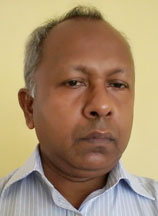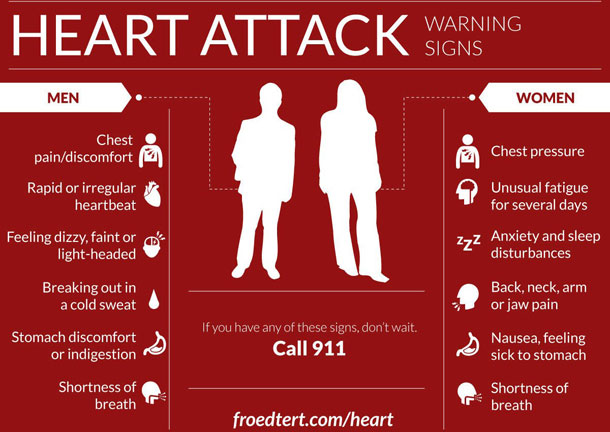Sudden chest pains?
It could be a heart attack! :
by Carol Aloysius
Heart diseases have reached epidemic proportions in today’s world of
fast living, fast foods and unhealthy lifestyles.
 Overtaking communicable diseases, this malady of contemporary society
has the dubious distinction of being the leading cause for morbidity and
mortality in most persons over 60 years. Overtaking communicable diseases, this malady of contemporary society
has the dubious distinction of being the leading cause for morbidity and
mortality in most persons over 60 years.
Years of stuffing oneself with foods rich in carbohydrates, oil,
sugar, and salt has resulted in persons even younger than the usual 60
year limit to suffer from heart attacks, as evidenced in many Western
countries.
Sri Lanka is no exception. In a country where fresh fruit, vegetables
and fish are readily available, most people are now switching to
convenient foods they can cook, fry and take away in an instant, like
hamburghers, potato fries, pastries, cakes, and instant noodles.
In many families where both parents work, these instant meals are
often served for all the main meals which has led to children becoming
fast food addicts, thus laying the foundation for early development of
non communicable diseases leading to heart disease.
Heart disease is treatable. Mortality rates have greatly reduced due
to the availability of excellent healthy facilities. It is also
preventable.
Preventing heart disease is the key to healthy longevity, says
Cardiac Surgeon, Karapitiya Hospital, Dr Namal Gamage who offers some
sound advice from his long years of experience on how to prevent a heart
disease, and how patients who have undergone by pass surgery can live a
near normal life by adhering to some simple rules on exercise and diet.
Excerpts from an interview with the Sunday Observer…
Heart diseases and stroke have been identified as the leading cause
for morbidity and mortality in Sri Lanka. Compared to a decade ago there
is a significant increase in the number of patients? Why?
A. Causative factors like diabetes, smoking, bad dietary
habits have gone up. Quality of drugs used to control causative factors
has gone down, resulting less than optimal diabetes, high blood
pressure, high cholesterol control.
Population has also gone up and data recording and statistics are
better. Toxic substances in the diet and in the environment also play a
big role in the increasing number of heart diseases.
|

Cardiac Surgeon, Karapitiya
Hospital, Dr Namal Gamage |
Hospital admissions indicate the age of patients is much younger than
it was about ten years ago. What is the average age of those at highest
risk of getting a heart disease today, compared to before?
A. Heart diseases like many other non communicable diseases go
up in prevalence with increasing age. So the older the age group, the
higher the risk. However, today, more and more younger groups are
vulnerable to the disease, due to exposure to the causative factors
mentioned.
Despite heart diseases being widely prevalent in Sri Lanka, many
people still remain ignorant about how they are caused and how they can
be identified, often mistaking the early symptoms for angina , gastritis
or a passing chest pain caused by sleeping in an awkward position. Your
comments?
A. Any chest pain with no obvious reason must be regarded as
originating from the heart till it is said to be otherwise, by a
qualified person. So it is important to get yourself checked by a
qualified physician immediately. If mistaken for something else, like a
chest pain, a pain from the heart - could be deadly, unlike in the case
of chest pains.
Are cardiac diseases and stroke linked? How?
A. They go hand in hand. Heart diseases are the number one
cause for natural death, and stroke is the second leading cause. Their
causative factors are identical.
What is Ischaemic Heart Disease?
A. The heart is a pump which pumps blood to the whole body. In
this pump, heart muscle provides energy and the heart valves keep the
direction of blood flow. To provide energy the heart muscle must have a
good blood supply which is done through coronary arteries. Narrowing of
these leads to ischaemia of heart muscle resulting in Ischaemic Heart
Disease.
Can someone with a history of heart diseases in the family be more
susceptible to it?
A. Yes, most of the heart diseases originating from non
communicable causes go in families, unlike in communicable diseases.
Communicable diseases originate from a microbial organism or a germ.
This type of heart disease is rare and don’t go in families.
Are persons with pre-disposed conditions like diabetes and
hypertension more vulnerable to them?
A. Yes. Diabetes, hypertension, high blood cholesterol, over
weight, work stress, smoking, renal disease, diseases of body
metabolism, hormone imbalances etc., all can cause heart disease.
What happens if these NCDs are not controlled in time?
A. If these causative factors are not controlled at the time
of a heart attack they continue to further aggravate the illness
rapidly.
Today, we live in a world of fast foods, fast paced lives and
invasion of modern technology, such as, the computer, internet and
television. This has resulted in less people adhering to healthy habits
. Are unhealthy lifestyles and poor diets as well as lack of exercise
contributory factors to precipitating heart diseases?
 A. Yes, they are. They do this directly by disarraying body
metabolism and /or indirectly by predisposing diseases like diabetes,
hypertension etc, which in turn can lead to heart disease. A. Yes, they are. They do this directly by disarraying body
metabolism and /or indirectly by predisposing diseases like diabetes,
hypertension etc, which in turn can lead to heart disease.
Once you get a heart attack can it recur?
A. Yes, that category is the most vulnerable for the next
attack than any other category .
How do you treat heart disease? Is it individual specific, or a
blanket treatment for all?
A. Both. The principles are: 1. Prevent further damage to the
heart while supporting life 2. Treat causative factors adequately. 3.
Try to improve cardiac functions if there are ways and means (e.g. by
stenting, coronary bypass surgery)
Can a person with a mild attack be treated at home? How?
A. No, certainly not. The severity of the attack cannot be
diagnosed at home. They need to be examined in a hospital setting,
however mild the attack.
Alternative treatments like homeopathy have also been tried out by
some patients with alleged success. Your comments?
A. I am yet to hear any positive response from patients who
have tried them.
On the contrary, I have experienced many disastrous situations over
the long years of my life, with heart patients.
In my opinion most alternative treatments for heart disease are non
scientific, cheating the less educated and superstitious patients who
they target, with the promise of quick recovery. It is not that they do
more harm than good, but they do only harm and no good.
What emerging trends in heart diseases do you see today? e.g. Is
paediatric cardiac disease on the increase? I understand there is a
Children’s Cardiac Unit at the NHSL and LRH. Is this due to a surge in
paediatric heart disease?
A. There is no significant increase in paediatric heart
disease, but due to improving diagnostic armamentorium, more cases are
now being diagnosed. Non invasive methods of treating, both, adult and
paediatric heart diseases are improving, qualitatively and
quantitatively.
Yet, they are barely adequate quantitatively. Dedicated paeditric
heart surgery unit is situated only at LRH .
In many government hospitals there are no separate cardiac units or
wards. In others there are High Dependency Units. Still others like the
private sector have state-of-the-art technology, separate cardiac
catheterization labs and a host of sophisticated facilities for cardiac
care. Do you see this discrepancy in services as a gap in our cardiac
care services?
A. Yes. This is due to failure in recognition of priorities by
the health policy makers. It applies to most other fields of health as
well.
In recent years there have been several new advances in treating
heart diseases. I understand that a group of tests and heart factors
have been proved to indicate a person’s chance of getting a heart
disease early, called Cardiac Heart Risk Assessment tests which include
– Lipid profile, VCDL and Cholesterol. What is a cardiac risk
assessment? Please explain.
A. The whole array of tests are mostly risk stratification
only. Hence, they are indirect .
Tests which image coronary arteries are the direct tests, ie coronary
angiography and CT coronary angiography.
Can someone who has had a heart attack lead a normal life, have
normal sex relations, continue to work?
A. Yes, it depends on the extent of the damage caused by the
attack. If the heart has a good functional reserve, near normalcy can be
achieved.
What is the role of exercise after a heart surgery?
A. Exercises are mandatory in cardiac rehabilitation. But,
they should be aerobic exercise only. Bodybuilding type anaerobic
exercises are discouraged for post surgery heart patients.
When should they start these exercises?
A. After a bypass surgery exercises are started as soon as
possible. Breathing exercises may be started immediately after surgery.
Thereafter graduated exercises are up titrated accordingly.
What about diet? What kind of food ( local ) should he/she take after
surgery or while on treatment? High fibre? Meat? Fish? Vegetarian?
A. They should have healthy diets. A healthy diet is rich in
fibres , has fresh less cooked green and leafy vegetables, less meat
products, less sweet, less salt, less saturated fat and less starch .
Fish with its skin is heart friendly. This applies to everyone who wants
to prevent a heart disease as well.
Do’s and Don’ts for heart patients?
A. Regular check ups, quality medicine and a good lifestyle.
|

